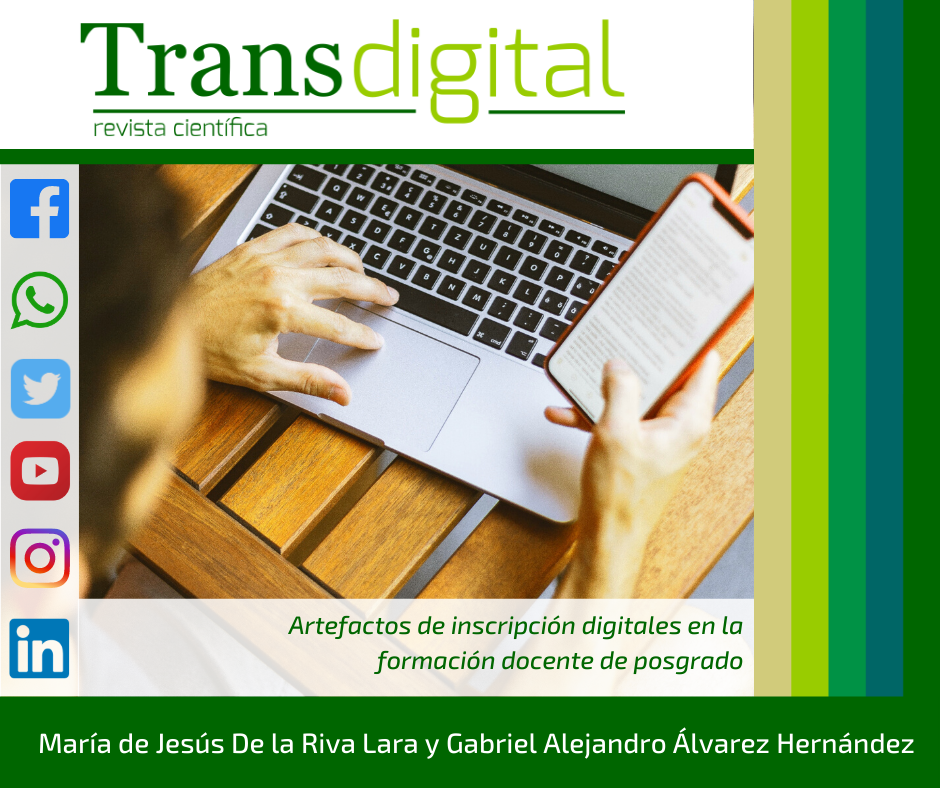Digital inscription artifacts in postgraduate teacher education
DOI:
https://doi.org/10.56162/transdigital32Keywords:
actor network theory, artifact, teacher training, pandemic, postgraduateAbstract
Faced with the pandemic caused by Covid-19, higher education institutions looked for alternatives to continue their activities in home. This document describes the case of the master's students of a public university who worked online for four weeks. These students are education professionals, mostly basic education teachers who simultaneously work online with their own students. The study aimed to find out which digital devices they have access to and how they use them combined in postgraduate sessions to build an inscription artifact. For this, a questionnaire was first applied via the Google Form to a sample of 35 students that showed the most frequent electronic devices, the most common uses and the various combinations between them. A 12-hour online class was also transcribed via chat, by a graduate teacher with six of her students. Four fragments of transcription were selected to analyze the constitution of network actors, the trajectories traveled by the references of the content that was intended to be learned and the planes in which the inscriptions were used
References
Alvarez, G. (2019-abril-17). Covid-19: Cambiar de paradigma educativo. EF Educación Futura. http://www.educacionfutura.org/covid-19-cambiar-de-paradigma-educativo/
Álvarez, A. (2019). Construcción y reconstrucción del objeto de estudio en la investigación educativa. Revista Actualidades Investigativas en Educación, 19(3), 1-21. Consultado en https://revistas.ucr.ac.cr/index.php/aie/article/view/38795
Callon, M. (1986), Some elements of a sociology of translation: domestication of the scallops and the fishermen of St Brieuc Bay. En: J. Law (1986) Power, action and belief: a new sociology of knowledge? (pp. 196-223). London: Routledge.
Candela, A. (1997). Ciencia en el aula. Los alumnos entre la argumentación y el acuerdo. México: Paidós.
Candela, A., Naranjo G., Moreno, J., De la Riva, M. y Rey, J. (en edición) (julio-septiembre, 2020). Teoría del actor red y contextos escolares. Revista Mexicana de Investigación Educativa, volumen XXV, número 86.
Candela, A., Rockwell, E. y Coll, C. (2009) ¿Qué demonios pasa en las aulas? La investigación cualitativa del aula. CPU-e, Revista de Investigación Educativa, núm. 8, enero-junio, pp. 1-128. Consultado en https://www.redalyc.org/pdf/2831/283121717001.pdf
Díaz Barriga, F., Romero, E. y Heredia, A. (2012). Dise o tecnopedagógico de portafolios electrónicos de aprendizaje: una experiencia con estudiantes universitarios. Revista Electrónica de Investigación Educativa 14(2), 103-117. Consultado en http://redie.uabc.mx/vol14no2/contenido-diazbarrigaetal.html
Erickson, F. (1986). “Métodos cualitativos de investigación sobre la enseñanza”. En: Wittrock, M. (Comp.) La investigación de la enseñanza II (pp. 195-301). Barcelona: Paidós-MEC.
Gil Antón, M. (2020-abril-18). Con la cera que hay. El Universal . https://www.eluniversal.com.mx/opinion/manuel-gil-anton/con-la-cera-que-hay
González-Patiño, J. (2011). Rutinas de la infancia urbana mediadas por la tecnología: Un análisis visual. Papeles de Trabajo sobre Cultura, Educación y Desarrollo Humano, 7(2). UAM.
INEGI (2020). Tecnologías de la información y comunicaciones. Instituto Nacional de Estadística, Geografía e Historia: https://www.inegi.org.mx/temas/ticshogares/
Kress, G., Carey J., Ogborn, J. y Tsatsarelis, C. (2001). Multimodal Teaching and Learning. The rhetoric of the science classroom. London: Continuum.
Latour, B. (2001). La esperanza de Pandora. Barcelona: Gedisa.
Latour, B. (1983). “Dadme un laboratorio y levantaré el Mundo”. Consultado en https://www.oei.es/historico/salactsi/latour.htm

Downloads
Autor de correspondencia
El autor de correspodencia se identifica con el siguiente símbolo: *Published
How to Cite
License
Copyright (c) 2020 María de Jesús De la Riva Lara, Gabriel Alejandro Álvarez Hernández

This work is licensed under a Creative Commons Attribution 4.0 International License.
All articles in Transdigital are licensed under a Creative Commons Attribution 4.0 International License. Authors hold the copyright and retain publishing rights without restrictions.









